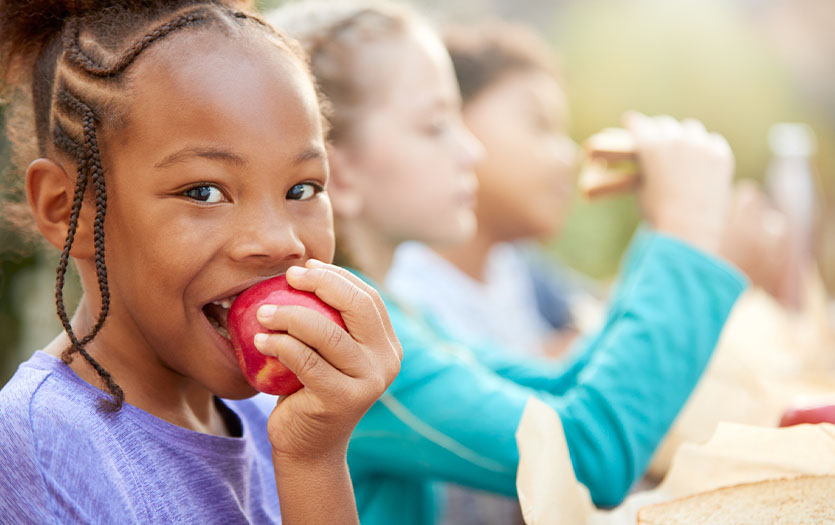
This post was written by Betsy Carmien, RDN, LD, clinical dietitian, Parkview Health.
Many parents struggle with getting their children to eat new foods. However, consuming a variety of foods is essential for children to get an adequate amount of nutrients needed for proper growth and development. You may not realize it, but eating behaviors develop early in life. Children often learn what, when and how much to eat through exposure and observing others around them. Parents and caregivers are role models and can influence their children’s food choices, behaviors and eating patterns through their selections for the family.
A successful start
Developing healthy eating patterns begins in the first few years of a child’s life. During this time, infants transition away from breastmilk or formula and turn to solid foods. The variety of foods caregivers provide helps lay the foundation for long-term eating patterns. As infants and toddlers get introduced to new foods, it’s also vital for them to see their caregivers eating a variety of foods as well. Caregivers should try new foods with positive behaviors to help children understand that trying something new is a normal eating habit.
Feeding style
Mealtimes should be a relaxed and positive environment for the entire family, but it’s also important to maintain an authoritative feeding style known as “Love with Limits.” Parents and caregivers should set clear limits and reasonable expectations with this feeding style. Listen to your child’s perspective, encourage independence and be flexible. Then, as you proceed with this feeding style, try applying a few of these methods:
- Provide a variety of foods at each meal.
- Always introduce new items at meals with foods your child is already comfortable eating.
- Set guidelines at meals. For example, your child needs to serve themself each item on the table.
- Remember, pressuring, bribing and threatening your child to try a new food will backfire.
Utilizing these techniques will help create a strong link between food and emotions. With no pressure to eat or try new items, children are more likely to explore more with the presented foods, providing them ample opportunities to see, touch and sample new things.
Push past picky eating
Developing children’s palates at a young age is crucial in forming their eating patterns. Parents and caregivers should strive to introduce as many foods as possible before their child starts showing signs of picky eating. In most cases, picky eating begins to develop around two years old. This is when many children start to think they need “special foods.” But, at mealtimes, everyone must have the same food choices. Remember, by providing a variety of delicious foods daily; your children can choose what interests them while enjoying the same foods everyone else is eating.
Expand your horizons
Don’t forget, eating should be fun! Trying a new food doesn’t mean it always has to be a vegetable. For example, if your child enjoys a very select group of foods, it’s important to create a variety within the realm of what they are already eating. Expanding your child’s diet can be as simple as introducing bowtie pasta instead of spaghetti or switching to whole grain pasta. Serving too many unfamiliar foods can be overwhelming for a child.
Also, don’t be afraid to get your child involved in the kitchen. It’s yet another way to expose them to new foods while making it fun. Try letting them help plan and cook the meals they will eat. Data has shown that children who help in the kitchen tend to eat food better.
Be your child’s cheerleader
You must be your child’s biggest encourager. Instead of asking your child if they liked the new food, ask what it tasted like compared to the food they know. Discuss the color, texture and flavor. This type of conversation encourages your child to explore and think through their food. If your child doesn’t immediately like the food when trying it, let them know that it’s okay. They may like it the next time you offer it. Remember, it can take a child up to 20 trials before accepting a food.
Final thoughts
While the first few years of a child’s life may be the optimal window for promoting and developing healthy eating behaviors, it’s never too late to start. Remember, your child’s preferences become influenced by availability, accessibility, familiarity and parent modeling. You play a critical role in developing your children’s food preferences. Early introduction of various foods and positive, repeated exposure are all great tactics to provide a strong foundation for developing healthy eating behaviors and patterns for your child.
References
Fox MK, Pac S, Devaney B, Jankowski L, Feeding Infants and toddlers study: What foods are infants and toddlers eating? J. A, Diet Assoc. 2004; 104: S 22-30
Birch L, Savage J, Ventura A, Influences on the Development of Children’s Eating Behaviors: From Infancy to Adolescence. Can J Diet Pract Res. 2007; 68(1): s1-s56
Ellyn Satter. Child of Mine: Feeding with love and good sense
Nicklaus S Development of food variety in children. Appetite. 2009, 52: 253-255
Birch, L.L. & Marlin, D.W. I don’t like it; I never tried it; Effects of exposure on two-year-old children’s food preferences. Appetite, 1982, 3, 353-360



